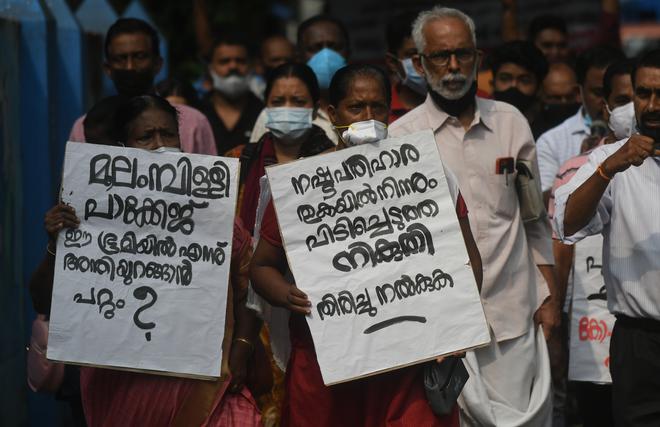Anti-Silverline activists cite the 4.62-km-long railway bridge, the longest such structure in India and part of the 8.86-km railway line that was commissioned between Edappally and the Vallarpadam International Container Transshipment Terminal, and the flawed rehabilitation of families as an apt example of lopsided priorities of those in power, what with an average of one train passing through the rail corridor per week.
They draw parallels between shoddy patronage for this dedicated rail line whose bridge works alone cost ₹350 crore in 2010, and the proposed ₹63,000-crore Silverline semi-high-speed rail project that has been envisaged between Thiruvananthapuram and Kasaragod.
The environmental cost of the bridge can be assessed from the fact that each of the 1.2-diametre piles were driven to an average depth of 55 metres and the total pile length was 65,000 metres. Another 11,700 tonnes of reinforced steel, 58,000 tonnes of cement, 99,000 cubic metres of metal aggregate, 73,500 cubic metres of sand, 1,27,000 cubic metres of concrete work and 1,54,308 cubic metres of earth work went into building the railway line.
The social impact was such that a total of 12.5 hectares was acquired for the rail link, displacing many hundred families. “A bulk of them have not been rehabilitated to date, neither provided jobs that were assured in the terminal project,” said Felix Pulloden, social activist.

“The project’s rail line remains a mere concrete monument, a decade since its commissioning. Evicted families who were rehabilitated in a marshy land at Thuthiyoor beyond Kakkanad now live a pitiable life, since over two dozen of the houses that they built are not safe for use due to the marshy nature of the land. In comparison, over a lakh families would have to be evicted for SilverLine rail, a project whose estimate is expected to escalate from ₹63,000 crore to up to ₹2 lakh crore by the time it is completed,” he said.
Railway sources confided that the present frequency of one container-laden train a week over the dedicated rail track could fall further once the Vizhinjam Port is commissioned. “This is because unlike Vallarpadam, almost the entire load of cargo to be handled at Vizhinjam is expected to be ferried by rail,” they added.
S. Rajeevan, the general convener of Samsthana K-Rail/SilverLine Virudha Janakiya Samithi, a conclave of organisations on the warpath against the SilverLine project, said the flawed rehabilitation of people who were evicted from Moolampilly and other places for Vallarpadam rail line, is proof of what is in store for tens of thousands of families who could be evicted for SilverLine.
“The State government violated its written agreement to evictees in Moolampilly, which included the promise of one job per affected household at the container terminal. And evictees would have to fend for themselves, registering their new land, readying house plan and utilities, spending considerable time and effort. And it is most likely that isolated tracts of land will be identified for rehabilitation,” Mr. Rajeevan said.







